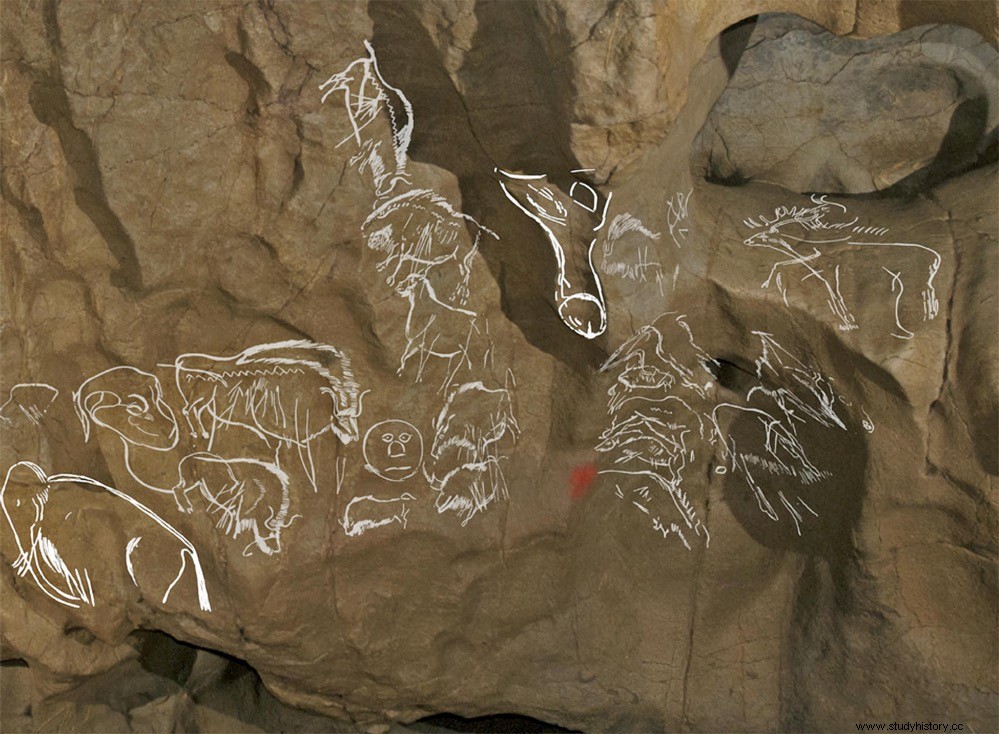Very close to the French town of Montesquieu-Avantés, in the Midi-Pyrénées region, and to the Tuc d'Audoubert cave, whose fantastic prehistoric clay bison we have already reviewed in another article, is the Trois Frères cave (Three Brothers).
Both are part of an underground system of three caverns formed by the Volp river (the third is the Enlène grotto), being the Trois Frères cave, 430 meters deep, the one with the richest set of parietal art consisting of paintings and Engravings from the Magdalenian period (17,000–10,000 BC).
It was discovered by the three sons of Count Henri Bégouen (Max, Jacques and Louis, as well as two friends) in 1914 (hence its name), who two years earlier had also found the Tuc d'Audoubert. And like this one, it was studied by the archaeologist and clergyman Henri Breuil, a pioneer in Paleolithic art research and the first professor of prehistory at the Collège de France, between 1920 and 1938.

Breuil identified among the cave paintings and engravings some of the most unique and significant representations of Palaeolithic art. First, up to seven anthropomorphic or therianthropic figures (half human-animal). In addition, in a bison bone fragment, he found the image of a grasshopper, today considered the first known representation of an insect.
To this we must add several engravings of animals such as lions, owls and bison, a horse covered with claviform symbols, and a strange bear pierced by a kind of spear vomiting blood.

Breuil made drawings of all this, which became popular throughout the world thanks to the great diffusion of his publications. A more detailed study, accompanied by hundreds of drawings, was published in 1958 by Breuil himself and Bégouen. And in 1967 the first photographic study was carried out. In total there are about 350 figures:84 horses, 170 bison, 20 ibex, 40 reindeer, 8 bears, 6 felines, 2 mammoths, 1 rhinoceros, 6 birds, 7 anthropomorphic figures, 5 hand prints, and numerous symbols and abstract signs. .
Of all the representations, the one that interests us here is the one called The Sorcerer . It is located in one of the small interior cavities known as the sanctuary , whose walls are covered with some 280 (the cavity that contains the most of all) superimposed drawings and engravings of reindeer, bison, horses, goats, bears, mammoths and anthropomorphic figures. Above them, about 4 meters high from the base of the cave and dominating the whole complex, appears the Sorcerer .
It represents a human figure, but with features of other animals, although its characteristics remain controversial. Let's see why.

Breuil studied and drew it during his early research in the 1920s, and its publication soon made it one of the most famous examples of European prehistoric art. In the detailed drawing of him he represented an anthropomorphic being, with human legs, bear paws, horse tail, deer antlers, bison beard and owl eyes.
Soon hypotheses about its meaning began to emerge. Some wanted to see in him a sorcerer practicing some kind of ritual (hence the name given to him), others a shaman (Breuil himself was convinced of this), a spirit and even a divinity. Something completely unheard of in paleolithic wall art.
The problem is that modern photographs show quite a different figure. There is no trace of the antlers, and the rest of the Sorcerer it hardly resembles Breuil's drawing except in silhouette. Some historians believe that Breuil could have confused some cracks and natural marks on the rock, taking them for parts of the figure, while others believe that they are intentionally engraved marks and that they are part of the whole together with the painting, but they are so fine that they cannot be seen. appreciate in the photographs, due to the poor light.

For example, Jean Clottes, one of the most outstanding French prehistorians, affirms, without any doubt, that Breuil's drawing is correct, and points out that he himself has been able to verify it in situ in the grotto about 20 times:
What virtually all researchers agree on is that the Sorcerer de Trois Frères is a key figure for the understanding of prehistoric parietal art, and must have been a cult object of great importance for the community that used the grotto.
